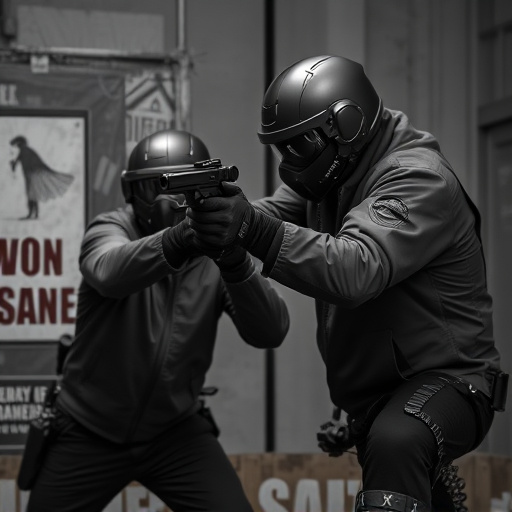College students considering self-defense stun guns must navigate a complex web of state and local regulations, with restrictions varying widely from minimal requirements to strict prohibitions. Understanding these laws, including age limits and permit needs, is crucial before purchasing. Effective usage requires training in deployment, de-escalation, and recognizing when to use the stun gun as a last resort, alongside proactive safety measures like alertness and awareness.
“Exploring the legalities of self-defense stun guns, this comprehensive guide navigates the intricate state-by-state regulations. Understanding these restrictions is vital, especially for college students seeking personal safety measures.
We delve into the ‘Understanding Self-Defense Stun Guns’ to demystify their role in defense. Then, we explore the ‘Legal Landscape’—a state-by-state analysis of stun gun laws. Additionally, ‘College Students and Stun Guns’ provides insights on navigating these regulations.
For responsible ownership, our ‘Tips for Staying Safe’ offer crucial advice, ensuring students make informed decisions regarding self-defense stun guns.”
- Understanding Self-Defense Stun Guns: A Comprehensive Overview
- Legal Landscape: State-by-State Regulations for Stun Guns
- College Students and Stun Guns: Navigating Legal Restrictions
- Tips for Staying Safe: Responsible Ownership and Usage of Stun Guns
Understanding Self-Defense Stun Guns: A Comprehensive Overview
Self-defense stun guns, also known as electronic control devices (ECDs), offer a non-lethal means of protection for individuals in various situations, particularly college students navigating new environments. These compact and easily concealable tools have gained popularity among young adults seeking to enhance their personal safety while attending school or living independently. Stun guns work by delivering a powerful electrical shock when activated, temporarily paralyzing an attacker and allowing the user to escape.
For college students, understanding the legal aspects of stun guns is crucial for responsible ownership. Different states have varying restrictions and regulations regarding the possession and use of self-defense stun guns. Some states allow them with minimal restrictions, while others require permits or have stringent guidelines on their use. It’s essential to research and comply with local laws to ensure legal carrying and effective self-protection without legal repercussions.
Legal Landscape: State-by-State Regulations for Stun Guns
The legal landscape surrounding self-defense stun guns for college students varies significantly from state to state in the U.S., reflecting a complex interplay between public safety and individual rights. Each state has its own set of regulations, ranging from strict prohibitions on stun gun possession to relatively lenient attitudes towards their use. Understanding these laws is crucial for any student considering self-defense options while attending college.
College campuses often present unique challenges in terms of security and personal safety, prompting many students to explore alternatives to traditional firearms for self-protection. Stun guns, known for their non-lethal capabilities, offer a controversial yet popular choice among those seeking effective self-defense measures. However, before purchasing or carrying a stun gun, students must familiarize themselves with the specific legal restrictions in their home state and any jurisdictions where they may temporarily reside or travel. These regulations can dictate age requirements, permit necessity, and even the type of stun gun allowed.
College Students and Stun Guns: Navigating Legal Restrictions
College students considering carrying self-defense stun guns for protection on campus need to be aware that laws vary greatly from state to state. While some allow for easy access and possession, others have stringent restrictions or outright ban them. This can make navigating self-defense options confusing for young adults attending school away from home.
Many college towns in states with lax stun gun regulations still have local ordinances that must be followed. Students should check with their school’s public safety department and local law enforcement agencies to understand any additional rules or requirements. Additionally, they need to stay informed about any changes in state legislation that could impact their right to carry a stun gun for self-defense on campus.
Tips for Staying Safe: Responsible Ownership and Usage of Stun Guns
Stun guns, while powerful tools for self-defense, come with a set of legal and safety considerations, especially for college students looking to protect themselves on campus. The first step in responsible ownership is understanding your state’s regulations. Each U.S. state has its own laws regarding stun guns, including age restrictions, permit requirements, and places where they can be carried. College students should check with their school and local authorities to ensure compliance with these rules. For instance, some states allow stun guns without a permit, but have restrictions on the voltage or size, while others may require registration or a concealed carry permit.
Safe usage involves understanding the device’s capabilities and limitations. Stun guns are designed to incapacitate an assailant temporarily through strong electrical shocks, but they should be used as a last resort. Students should receive proper training in stun gun deployment techniques, including safe handling practices and de-escalation strategies. It’s crucial to remember that self-defense isn’t just about the weapon; staying alert, knowing your surroundings, and avoiding potential dangers are equally vital components of personal safety.
Understanding the legal restrictions surrounding self-defense stun guns is crucial, especially for college students considering their personal safety. Each state has its own regulations, making it essential to stay informed about your rights and responsibilities. By navigating these laws, you can ensure responsible ownership and usage of stun guns as a viable option for self-defense on campus. Remember, knowledge is power when it comes to staying safe in today’s world.
